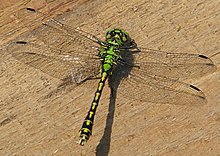
The red-veined darter or nomad is a dragonfly of the genus Sympetrum.

The beautiful demoiselle is a species of damselfly belonging to the family Calopterygidae. It is found in Europe, North Africa, and Western Asia. It is often found along fast-flowing waters.

The Gomphidae are a family of dragonflies commonly referred to as clubtails or club-tailed dragonflies. The family contains about 90 genera and 900 species found across North and South America, Europe, Asia, Australia, and Africa. The name refers to the club-like widening of the end of the abdomen. However, this club is usually less pronounced in females and is entirely absent in some species.

The dragonhunter is a clubtail dragonfly of the eastern United States and southeastern Canada.
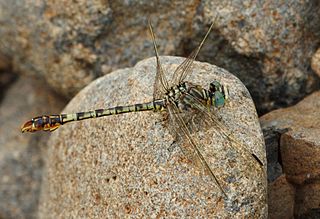
Crenigomphus hartmanni, the clubbed talontail, is a species of dragonfly in the family Gomphidae.

Ophiogomphus, commonly known as snaketails, is a genus of dragonflies in the family Gomphidae. Most of the species in the genus Ophiogomphus have beautifully marked green club-shaped abdomens, which are more noticeable in the males.
Ophiogomphus howei, the pygmy snaketail, is a species of dragonfly in the family Gomphidae. It is endemic to the United States. Its natural habitat is rivers.

Trithemis annulata, commonly known as the violet dropwing, violet-marked darter, purple-blushed darter, or plum-coloured dropwing, is a species of dragonfly in the family Libellulidae. It is found in most of Africa, the Middle East, and southern Europe. These dragonflies are called dropwings because of their habit of immediately lowering their wings after landing on a perch. Males of this species are violet-red with red veins in the wings, while females are yellow and brown. Both sexes have red eyes.
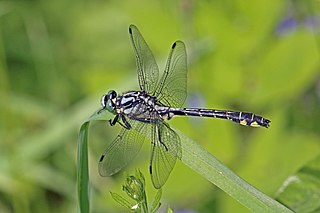
Gomphus vulgatissimus, the common clubtail, is a medium-sized species of dragonfly in the family Gomphidae. It is found in most of Europe, and is present now in the south of France. Its natural habitats are clean, slow moving streaming rivers and creeks with sandy soil. It can be seen from mid-April in the south to August. Once they hatched out of water, they live shortly. As the common name suggests, this medium-sized species has a distinctive club-shaped abdomen. The males are black with extensive yellow markings on the thorax and abdomen which turn green as the insect ages. The females are black with extensive yellow markings. In the British Isles the adult flight period extends from mid May to early July.
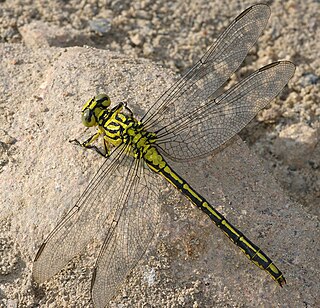
Gomphus flavipes, the river clubtail or yellow-legged dragonfly, is a species of dragonfly in the family Gomphidae. It is found in Europe. Its natural habitat are rivers and large streams. The dragonfly flies from June to September depending on the location.

Progomphus borealis is a species of dragonfly in the family Gomphidae. This dragonfly species is commonly known as the gray sanddragon.

Gomphurus externus, the plains clubtail, is a species of dragonfly in the family Gomphidae.
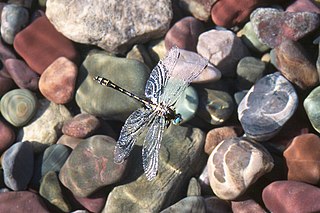
Phanogomphus graslinellus is a species of dragonfly in the family Gomphidae. This species is commonly known as the pronghorn clubtail.
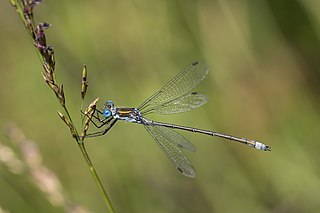
Lestes sponsa is a damselfly with a wide Palaearctic distribution. It is known commonly as the emerald damselfly or common spreadwing. Both males and females have a metallic green colour and brown wing spots. It resides near pools with aquatic plants. When resting its wings are usually half opened.

Lestes dryas is a species of damselfly in the family Lestidae, the spreadwings. Its common names include emerald spreadwing, scarce emerald damselfly and robust spreadwing. An alternate name in Ireland is the turlough spreadwing.
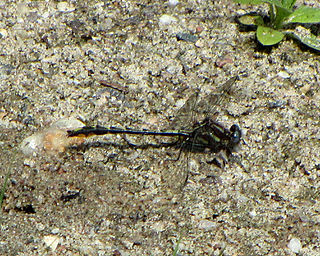
Phanogomphus exilis, the lancet clubtail, is a species of dragonfly in the family Gomphidae widespread and common throughout southern Manitoba, Ontario, and the northeastern United States.

Epiophlebia superstes, the Japanese relict dragonfly, is one of the four species of the genus Epiophlebia, belonging to the family Epiophlebiidae, which is itself the sole living representative of the epiproctan infraorder Epiophlebioptera.

Ictinogomphus rapax, the common clubtail, is a species of dragonfly in the family Gomphidae. It is found throughout the Indomalayan region.

Onychogomphus forcipatus, the small pincertail, green-eyed hooktail, or green-eyed hook-tailed dragonfly, is a species of dragonfly belonging to the family Gomphidae.
